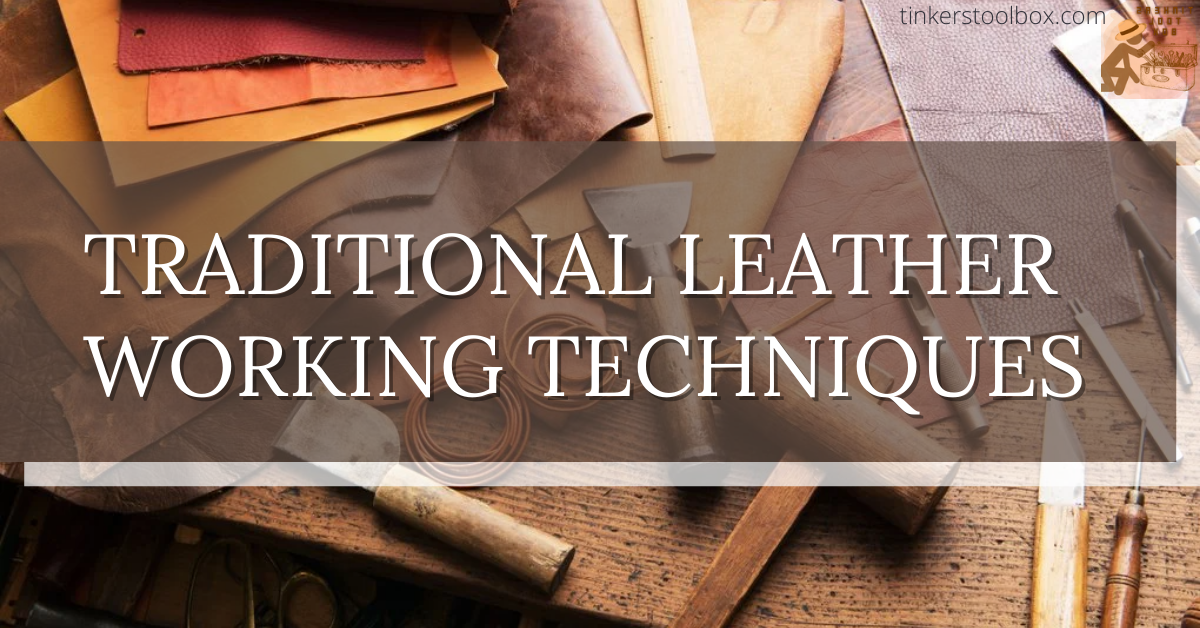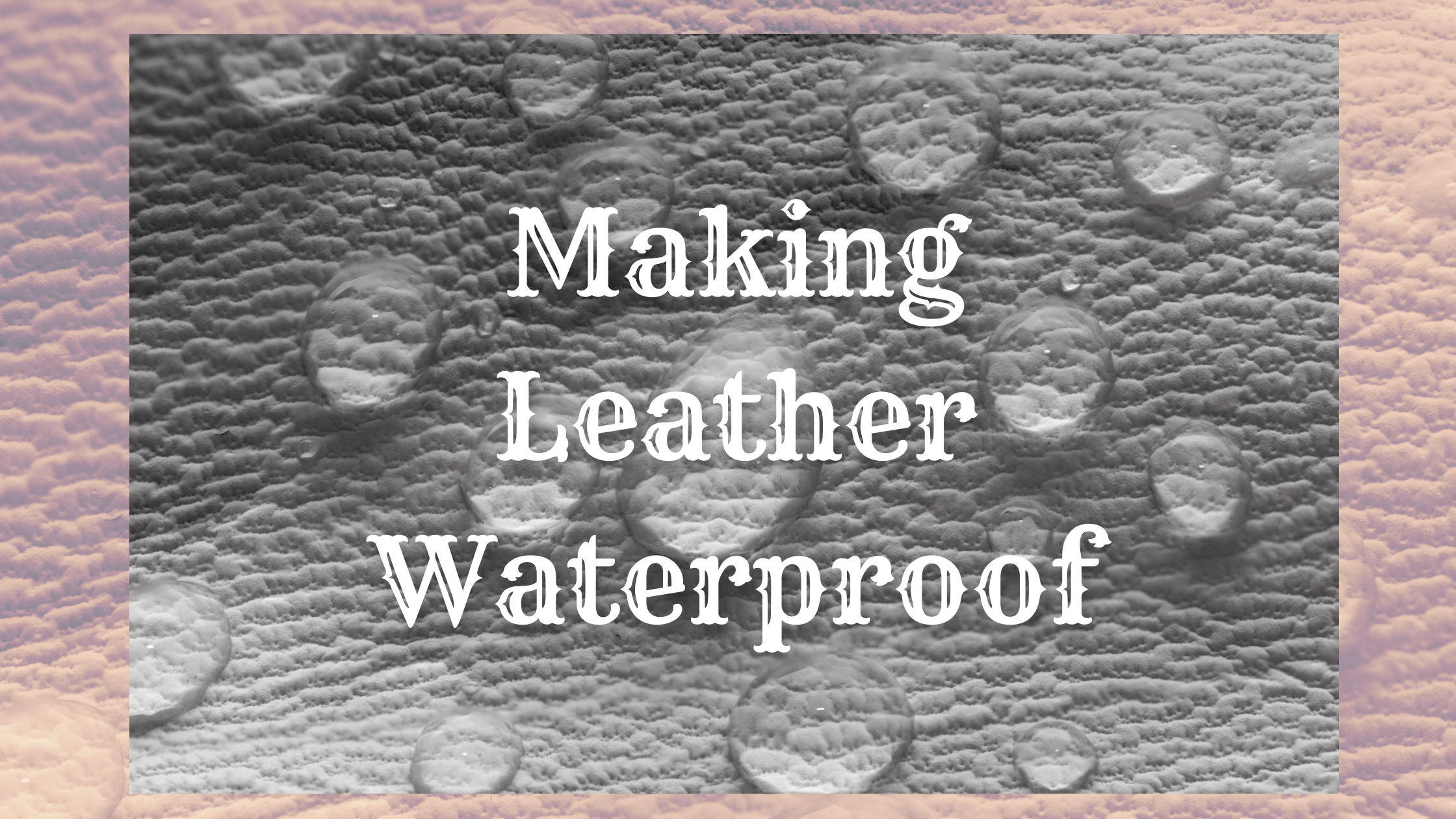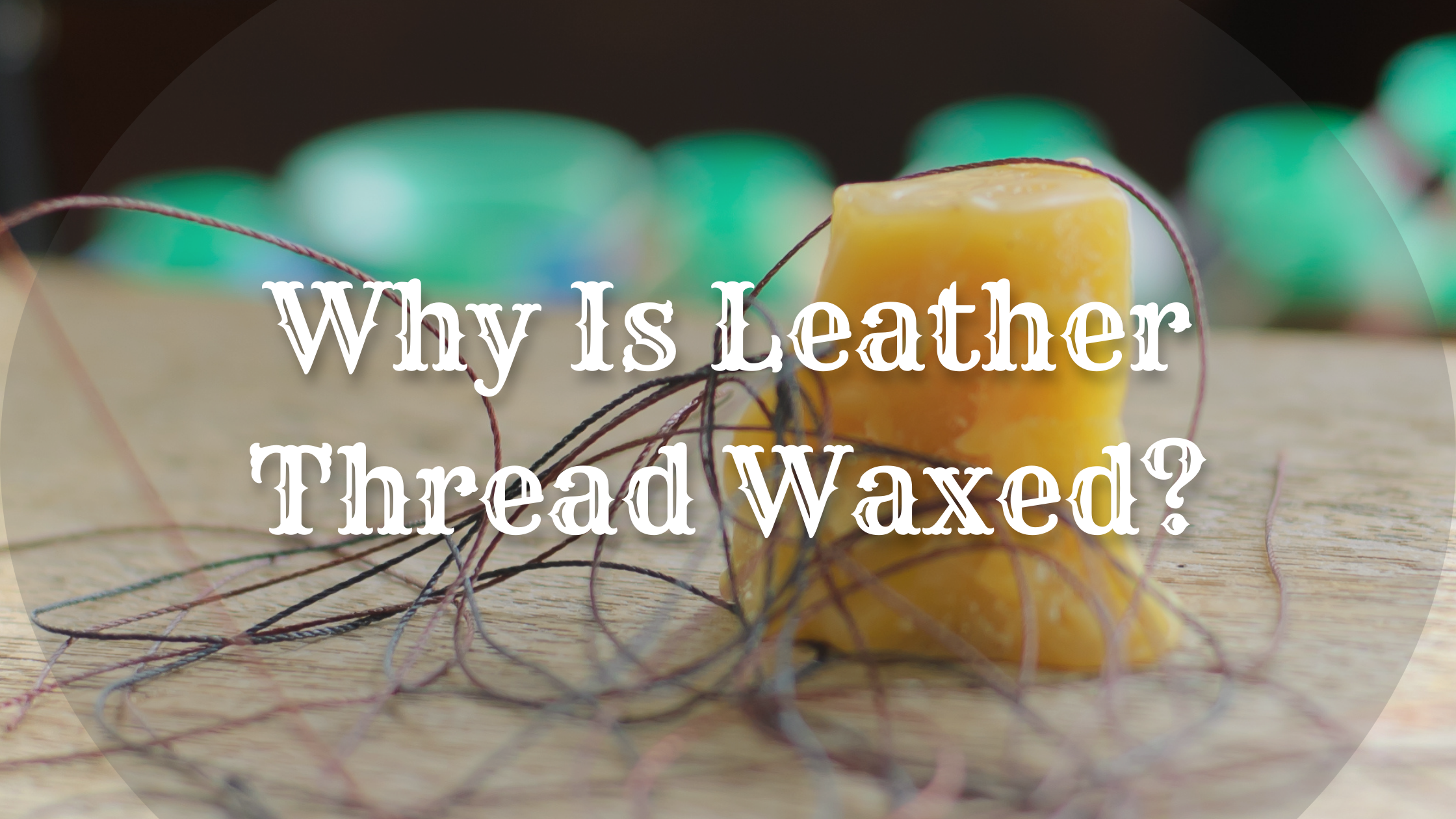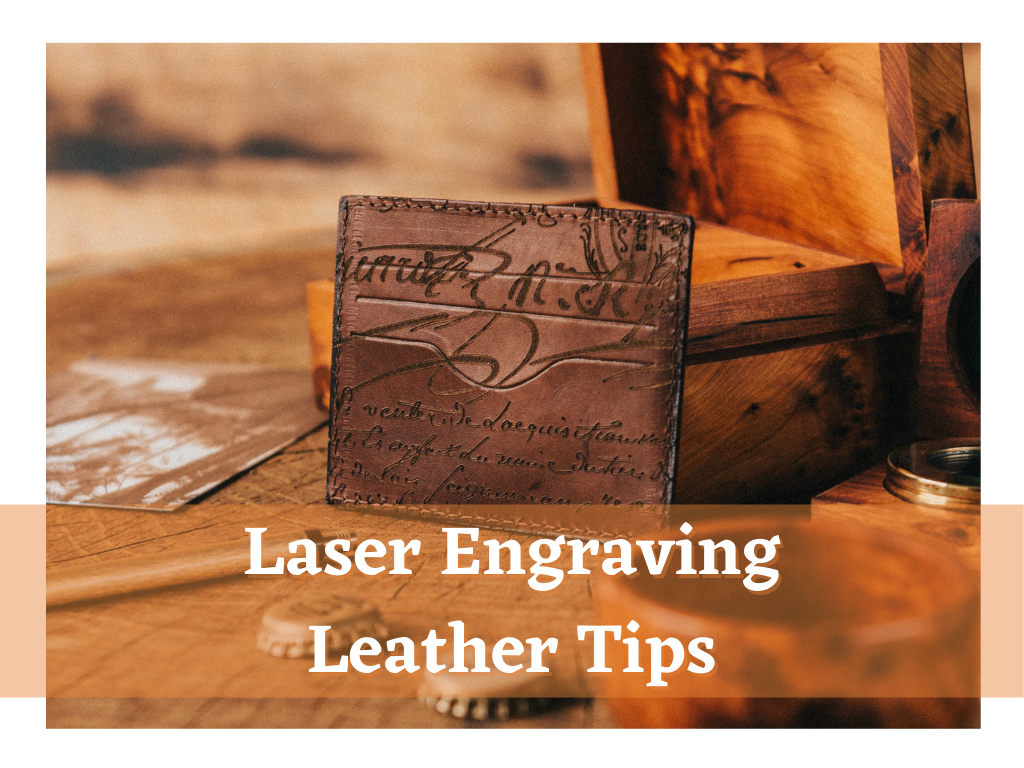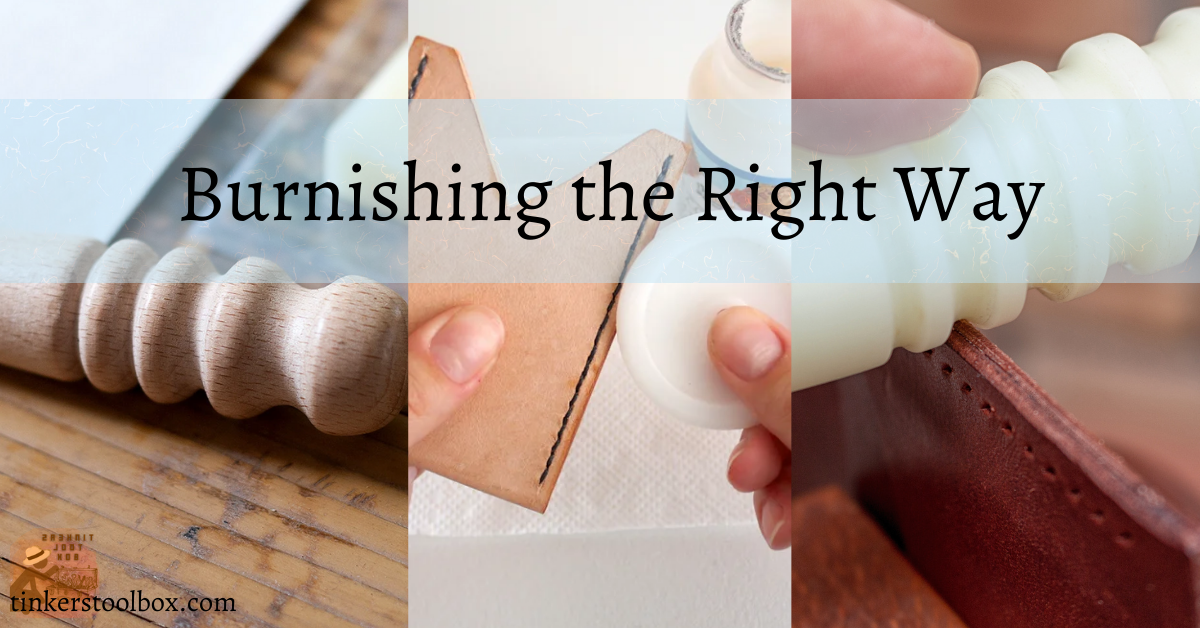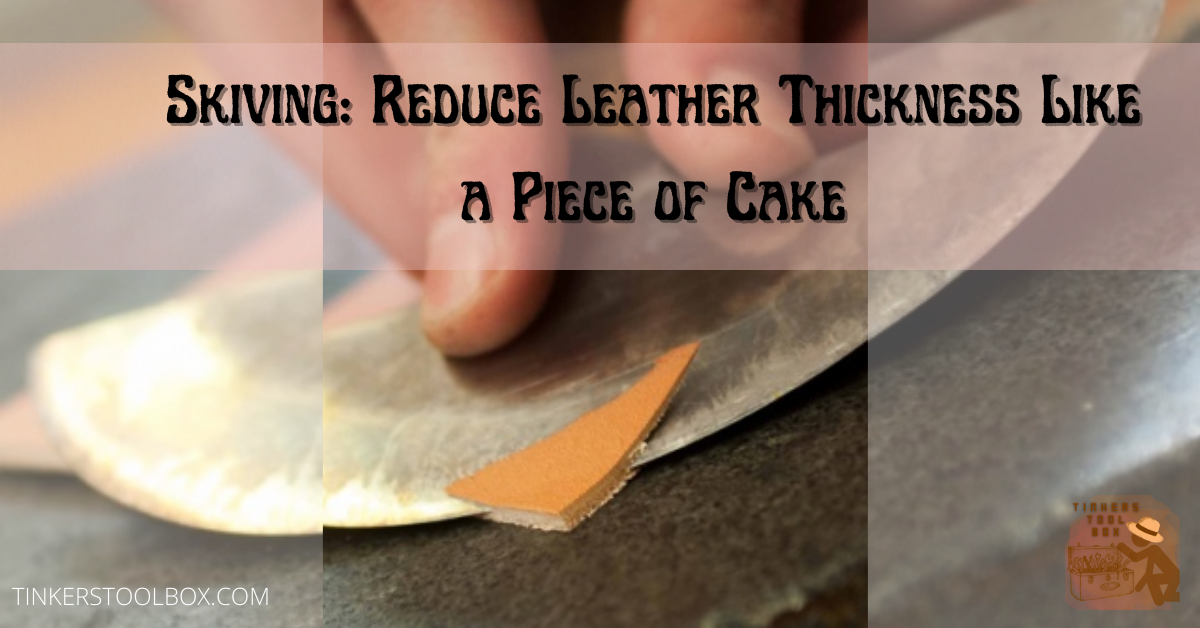Leatherworking is undeniably one of the most respected crafts today. Since time immemorial, animal hide or leather has been utilized to protect everyday use and on the battlefield in many regions. Over time, many techniques have arisen to produce a better leather product. Still, a part of these is traditional leather working techniques that paved its development and an inspiration to the new generation of leather artisans. Knowing these conventional techniques will be best to produce and innovate more significant leather products for the future.
When I first took an interest in leatherworking, I usually read and learned mostly modern ones. These are extensively taught in online videos, in a formal school, or retained by personal experience. In this long-overdue pandemic, I started to explore traditional techniques, which I can use to improve my craft. This article enumerates the list of traditional methods and a glimpse of the past. Like me, you can utilize these traditional leather working techniques for an even greater leather output.
A Brief History of Leatherworking
Before modern techniques were utilized, traditional leather working was already present, a part of leather crafts in historical times. It paved the way for developing the new methods, but it is essential to look back to these traditional ones that are important in the timeline of leathercraft development.
Large Part of the History
The use of leather started during prehistoric times that have been a part of any civilization and era dates back to 1300 BC. The idea of using animal skin or hide as protection against harsh weather conditions paved the introduction of this craft. Leather is unique because of its flexibility and pliability for any form or design yet very durable.
Some of the civilizations that utilized leather are Ancient Greeks, Egyptians, and others because they became more interested in animal skin than its food benefits. It is a famous material also used by soldiers to craft hard armors and sandals for battle. Leather is also used in bookbinding. Leather has a point in history where it became very localized and then was industrialized.
Inspiration for the Future
The natural, intrinsic character of leather is what makes it unique from other materials. The traditional techniques are the best to avoid over-processing the leather, which results in the loss of its natural look that makes it interesting. Hence, these techniques are an inspiration for the future for more innovations and sustainable ways to produce leather and continue its craft.
Applique: Juts Attach It and Beautify The Leather
One cool thing you can do in leathercraft is to add ornaments to your product. Even during ancient times, people learned to add or attach objects in the leather to decorate it. It is one perfect tooling technique.
Technique Essentials
- A leather cutting tool like a utility knife or scissors
- Glue
- Needle and Thread
- Sewing machine (optional)
- Ruler
- Pencil
Things to Know
Applique is the term used to describe the technique of attaching ornaments on leather. The decorations may include paper mache, other leather, flower embellishments, and more. You can also cut pieces of leather in varying colors and glue them on another leather piece. It is economical because you can use scrap leather for your applique design. It can be classified as in-lay or on-lay.
In-lay applique or reverse applique requires skills more than beginners. While on-lay applique has the same concept as in-lay applique, instead of incorporating the leather together when stitching, you only need glue to paste the leather strip you like to add.
It is an excellent decorative technique because it is suitable for all types of leather. It can be done in natural or synthetic leather by hand or machine stitching.
Its Relevance To Leather Craft
It gives the leather a unique look by making use of scrap leather pieces. It can save you a couple of bucks because you can maximize excess leather in this technique.
Stamping: Leaving The Best Impression on Leather
If you want to explore how to produce a highly customized leather output, stamping it may be the best option for you. This tooling technique has been around earlier in the leather timeline. You can use any stamp of your desired design.
Technique Essentials
- Cutting knives and scissors
- Water
- Dabber/sponge
- Metal or leather stamp
- Hammer
- Leather
- Tracing Paper
Things to Know
It is one type of ornamentation technique, also called leather tooling. It is where a stamp is placed on the leather using a hammer or mallet. Stamping leaves a 3D mark on the leather piece with varying designs, sizes, and styles depending on the stamp used. Stainless or carbon steel stamps are ideal to use because they can withstand force and pressure when working on the leather.
The usual leather type used in leather stamping is veg-tanned leather because it does not have oils or waxes. The presence of these fat compounds can affect the longevity of stamps in the leather. It is not recommended to use chrome-tanned leather because it does not take a stamp too well. If you plan to use this, it should be paired with heat-pressing.
Its Relevance in Leather Craft
Stamping leather is not just for decoration or ornamentation. It can be used as a form of showing branding or other vital information. There are many available stamps on the market, and you can even customize them to offer more leather characters and structures.
Incision and Etching: Giving An Additional Look
If you think that leather stamping will not satisfy the ornamentation you want to do, you can try incision or etching the leather. It is another tooling technique that gives striking looks to leather.
Technique Essentials
- Knife
- Etching Tools
- Leather ideally full-grain or top-grain
Things to Know
It is a tooling technique along with stamping. Incisions or etching leather is a classic leatherwork decorative scheme that incites textural effects on the leather’s surface. It involves removing the leather’s top layer to expose the fibrous layer to show an intricate design. These incised or etched leather areas can be dyed, carved, or further improved depending on what you want.
In etching or incision, the best leather type to use is full-grain or top-grain leather.
You can try it on natural leather, which includes suede and nubuck. All these types will produce excellent etched output.
Its Relevance To Leather Craft
Lather etching or incision can show branding, logo, or family sigils during ancient times even today. It is done for decoration, especially in that it creates contrast in one leather product.
Carving: Getting the Most Out Of Leather Adornment
If you are not comfortable with stamping or etching, another tooling technique you can try is carving. You can put decorations on your leather that can even showcase your creativity.
Technique Essentials
- Swivel knives
- Stamps
- Number and alpha stamps
- Accessories
- Embossing wheel
Things to Know
A traditional procedure of leatherworking and is used for adding decoration. It uses carving tools to form the desired pattern, such as lines, grooves, curves, and other designs.
It was extensively practiced during the middle ages in Europe, and only a few saddlers can do this in Germany. Before carving the leather, it is usually wet and moistened beforehand. It is done repeatedly along the carving process until the desired design is reached. In carving, a great force is needed to engrave the design on the leather.
Without a binder-based finish, leather types with enough stability and rigidity are best for leather carving, such as fine-grained, thick, vegetable-tanned leather. Any leather which is chemically processed is not ideal because it will be tough to tool.
Its Relevance To Leather Craft
The decoration produced by carving is like the artist’s signature. Every leatherworker develops their own set and style of decorative cuts shown in their leather carved masterpieces. It is still applied today and used to create more sophisticated tools for carving.
Molding/Shaping: Giving the Leather A New Face
If you are not content with your leather’s flat shape, you can explore one traditional technique called leather molding or shaping. This can give your leather a new look and make your desired shape.
Technique Essentials
- Paper mold/template
- Pans for both cold and hot water
- Drying Rack
Things To Know
It is a method used to shape leather so that it will hold the desired form over time. It can form around specific objects like a gun or knife or create a solid structure for pouch-like projects. Leather is molded to a particular item, and it will mimic the shape and design of the set object. Other forms of wet molding can also be used to create various designs.
It is done by soaking the leather in the water at different temperatures to give the leather a new shape and make it strong and resistant. Like other tooling techniques, veg-tanned leather is ideal for molding. This type holds the shape better as long as you select the right thickness you want.
Its Relevance To Leather Craft
It can give another shape to the leather. By providing or creating a new leather shape, the leather can be used for other purposes. The process of leather molding makes the leather even more robust and resistant.
Tanning: The Secret Of Enhancing Leather’s Durability
People alter the leather properties by tanning. It utilizes chemical or other natural treatments. Tanning also makes the leather even more durable. It may be foul, but the finished product will turn out fancy.
Technique Essentials
- Natural tannins (The wood of the oak and chestnut, Willow’s bark, larch or Fir, pigeon dropping)
- Aldehyde
- Chemical treatments
- Scraper
Things To Know
The use of animal skins started as early as the Stone Age. During this period, tanning was practiced for treating the skins and hides of animals for leather processing. This procedure permanently modifies the skin’s protein structure. The animal’s skin is purified by removing its hair and natural grease. The adhering flesh in the rawhide is removed and cured with salt. It is soaked in water for over two days.
Most leather objects made before 1886 were commonly vegetable tanned. One unique method of tanning in Morocco is soaking the rawhide in water and pigeon droppings. It will make the leather supple and soft. Some tanneries in Morocco do this manually, battling the stench that comes with fresh and rawhide.
It is also done through a chemical process that converts the hide or skin into leather. In the mid-1800s, leather crafters discovered chromium salts as a good tannin, leading to the chrome-tanned leather, making almost 80% of all shoes and bags today.
If leather is not tanned, it will rot and deteriorate quickly. Most common animal hides or skin are all tanned before getting the final leather product. The elements of tanning have changed very little over history because of its natural ingredients.
Its Relevance in Leather Craft
Tanning protects the leather from being dehydrated. The tanning processes always ensure that the leather maintains its inner moisture but protects the leather from decaying when subjected to water. It dramatically improves the leather’s tensile strength and makes the leather resist all kinds of weather conditions; thus, it can enhance leather life.
Dyeing: Adding Color To Leather Craft
Leather coloring or dyeing is simple, but it gives additional or changes the leather’s color. You apply a mixture of pigments over some time so that the leather can absorb the stain.
Technique Essentials
- Plastic bag to protect the working space
- Alcohol
- Oil
- Resolene
- A burnishing agent like gum tragacanth
- wooden stick or slicker
Things To Know
It is a combination of dyes and substances that are mixed and are used for coloring leather. The visible color of the leather changes when the colored pigment is applied with a base, usually oil, alcohol, or water, to the leather fiber. Some dyes penetrate deeply compared to others. Before the actual dyeing, the leather dye should be tested on scraps and must use a color chart as a guide before dyeing the final article.
A spacious and well-ventilated area is required when dyeing. The leather is cleaned, and oil is applied; usually, olive oil, to hydrate the leather. A first coat is initially applied using a soft cotton rag in a circular motion and allowed to dry. An additional coat is then applied, and drying is done between the coats. After the leather is dyed, a wax conditioner is applied to re-hydrate the leather.
The common types of leather that are dyed are veg-tanned natural leather. Natural veg-tanned leather is the most used type among leather crafters, chrome-tanned Leather. It is also suited for other kinds of leathers.
Its Relevance To Leather Craft
It is cost-effective, and it helps to restore the fabric to look new. It preserves the leather for more extended use.
Painting: Playing With Leather Colors
Leather paint is another decorative technique to enhance the appearance of leather. It has been widely applied in furniture for aesthetic purposes. You can also use leather painting to cover up blemishes or imperfections in your leather product.
Technique Essentials
- Paint
- Containers for mixing and stir sticks
- Water
- Clean cotton rags
- Scissors
Things To Know
Leather painting is a form of leather decoration. Historically, leather serves as a canvas for artistic designs. In modern times, it is used for products and painted for aesthetic purposes. Some painted leather is framed and displayed in museums or houses.
However, before painting is done, traces of any external oil or moisture must be removed by alcohol use. This procedure allows the paint to adhere to the leather. You can paint the entire leather or just a part of the leather for decoration. Leather painting, when done right, becomes a part of the leather through time. Choosing the right leather paint is crucial to prevent it from flaking off later on.
Its Relevance To Leather Craft
It enhances the leather product and showcases artistic works by producing aesthetically appealing leather products. Notably, It can cover blemishes and minor imperfections in leather and coat the leather from external abrasions.
Pyrography: Burn it With Passion and Creativity
Another way to get an impressive output is by using a burning tool and engraving design in the leather. It is a process called pyrography which has been performed before.
Technique Essentials
- A leather burning tool
- Leather
- Tracing/Carbon Paper or Stencils
- A Smooth surface
- Stylus/Pencil
Things To Know
It is a decorative leather technique that uses a scorching leather tool to burn designs on the leather’s grain surface. The surface burns beautifully and works best in vegetable-tanned leather because it is not chemically tanned. It is a process of burning designs or writing primarily on leather using a burning tool.
Its real aesthetic appeal is within its rustic sepia appearance. Many tones, highlights, and shade can be affected dramatically, and it is what makes it remarkable. The vegetable-tanned leather is used because it does not contain harmful chemicals when the leather is burnt.
Like other decoration techniques for leather, the primary purpose is for adornment and additional aesthetic appearance. It can be very appealing because of the rustic look and unique “burnt” smell in some products.
Its Relevance To Leather Craft
Pyrography is one-way artists expressing themselves. It is also used during old times to record history in animal hide and preserve their culture.
Embossing: Raising the Leather Surface For More Appeal
Creating a raised design in the leather is called embossing. It is done by the use of tools that come with or without color.
Technique Essentials
- Leather
- metal shape (metal leather stamp)
- Brush (Brush the leather with the sponge in one even layer)
- C-clamp ( optional/depends on what kind of leather embossing is making)
- Wooden mallet
Things To Know
Embossments are raised patterns or designs that appear on the natural grain of an animal’s skin. It is created by using tools to press or stamp designs on the leather. The embossed plans can cover a part of the entire surface of the garment. Then, leather or fabric is glued to the back to prevent the embossed motif’s stretching and flatten.
There are three common embossing types, namely blind Embossing (blind printing/blind finishing), where the embossed finish has no color. The second is gold embossing, where the transfer of gold leaf into the embossing media is done—lastly, Colour imprint or the transmission of color by color films in the embossment.
Its Relevance To Leather Craft
Like stamping, embossing can show the branding and logo of leather artists. It is a form of decoration that can be improved for a more sophisticated leather look.
Weaving: Leather Strips ique lookFor Impressive Patterns
Weaving is another technique used to give the leather a new design. It has been used in bags and furniture in recent times. It is time-consuming but will produce a delicate and resistant product.
Technique Essentials
- Leather strips ((for wrapping handles, , braiding, and, and weaving))
- Utility knife/Craft knife
- Manual punch
- Rubber mallet
- Sewel knives (used for detailed work)
- Leather shears
- Rotary cutters
- Cutting Mat
Things To Know
Weaving was a technique first done postwar period by mothers who wanted to transform typical products, including leather. Weaving is a Meditteranean technique, and leather is an excellent material to use for weaving because of its flexibility. technique can be confused by leather braiding. It. is a precise art, but it is also time consuming. The strip of leather used is manually cut by hand. It can. It can be used to make handbags, wallets, seat covers, shoes, and many more.
Its Relevance To Leather Craft
Weaving creates depth and pattern by overlapping thin strips together. It is a technique relevant to showcase the versatility of such material like leather.
Shearling: Getting the Fashion beyond Insulation: Keeping the Wool On
Shearling is utilizing sheepskin, processing it, and keeping a portion of the wool. Going back to history, it is not just for decoration but a reflection of one’s status.
Technique Essentials
- Sheepskin/wool
- Leather cutter
- Sewing machine ( hand sewing can be used alternatively)
Things To Know
Clothing is made from the skin and coat of a sheep or a lamb shortly before slaughter. The hide undergoes tanning with the wool still on it. Putting. It was used to represent both women and men before that were usually made into undergarments and hats. It was used mainly for protection against harsh winter months such that it insulates and retains heat naturally, even in frigid temperatures. It was used but not much during the stone age, iron age, and middle ages.
In the 1940s, it was used to make jackets and hats for pilots, and in modern times its use expanded to shoes, hats, and boots. Products of leather shearling are quite expensive today, considering the lightweight lambskin and dense wool. and .
Its Relevance To Leather Craft
Shearling is essential because it gives excellent insulation in icy areas. Since it is designed to have thin leather complimented with wool, you can wear it even during warm seasons. It is versatile and also moisture-resistant.Preserving The Tradition and Leather Product
With the influence of these traditional leather craft techniques, preserving this leather craft’s knowledge and practices is essential. Here are some ways the leathercraft industry keeps them alive.
Conserve the Practice
Some leather artifacts which were recovered in historical places are well preserved in museums. Traditional techniques are being documented in the form of books and online repositories. Some leather products made by conventional methods are kept in good condition by private owners, and other leather artists are still practicing these traditional leather working techniques.
Preserve the Leather Product
In preserving an antique leather product with a high historical value, you can add a conditioner to revive its condition. You can add saddle soap also to leather to prevent further damage. Just bear in mind that these products’ long-term use can cause the leather color to turn darker later.
Renaissance wax is ideal, which is also used by museums and other storage facilities. It is always better to prevent the damage as early as possible. Keep an ideal room temperature in the area where you hold your leather. Keep leather away from heat to avoid leather from getting brittle. Keep away alloy and iron materials since they can rot leather. Keep the leather piece as flat as possible, do not fold. Always keep your hands clean when handling leather.
Conclusion
Traditional techniques on leatherworking show that even before it was industrialized, its use has been widely practiced. Knowing the traditional methods is an inspiration for the future. These techniques should be preserved, which entails the history behind leatherworking. The modern leather workers and artists can get inspiration for a more improved product and showcase leather’s versatility through ages with modern tools and applications. Going back memory lane is also a pause in times like this.
